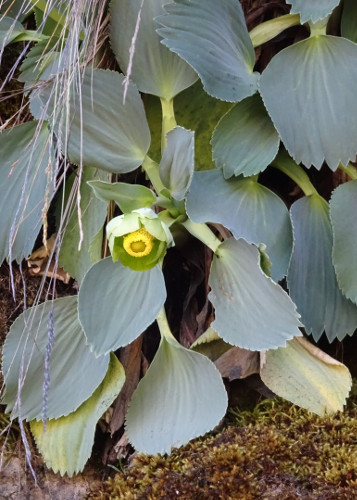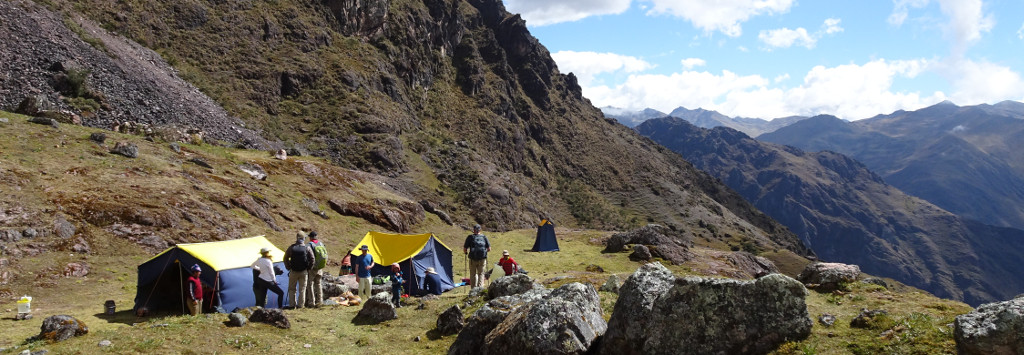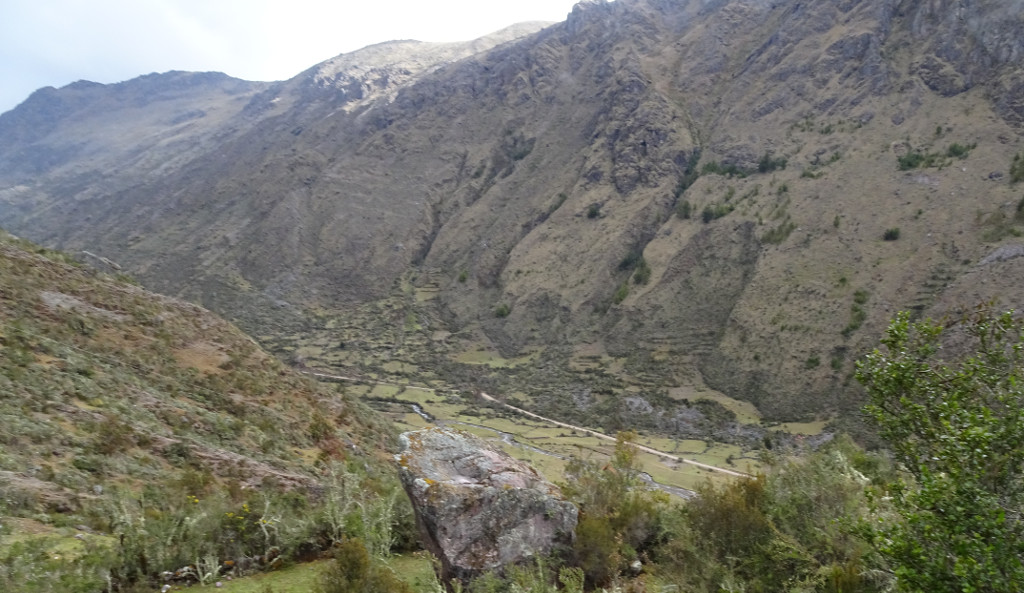Peru Day 5: Huchuyccasa Pass
7am departure in the van. Just one van: there were only eight of us doing today’s hike, nine with our guide, so we all fit in one van. We drove the hour to the tiny village of Quiswarani where (no surprise) several vendors spread their blankets of wares. We stretched our legs, peed, stuffed our cheeks with a giant wad of coca, and started off.
REI contracts with Quechua communities to offer access to remote and isolated trails—part of their promise is that we won’t be among hordes of travelers. (Do they do this responsibly? Fairly? I have no way of knowing but choose to trust them). So what we started off on was not so much a trail as a hint; a mere trace of differently-worn terrain on a steep hillside. The first ten minutes were actually kind of uncomfortable, requiring nimble and careful footing. Not yer-gonna-die terrain, but a slip could have consequences. (Neither Melchior—our Quechua mule driver, another part of the REI package—nor his mules seemed in any way concerned. Keep that in mind when considering my whining.)
After those first ten minutes, though, we met a fair trail. This was not wide gradual gentle Inca trail, it was just regular-use llama-herding and mountain-crossing trail. Rocky, uneven, and, near the passes, pretty steep at times. I was glad for my trusty old boots, even though (more on this later) they didn’t quite survive the trek intact.
Up we went, past a fenced-off preserve for a threatened species of tree, the vistas expanding with each step, until we crested a small hill and were met with the most unexpected tranquil lake. (And alpacas. But we were already used to alpacas. Enough already about alpacas.) We paused here, some to snack, some to catch breath, some to walk around the lake and marvel at how different it looked from each direction, how deeply it reflected sky and ground and hopes and fears and—oops, sorry, never mind.
Onward and upward; we still had another thousand feet to the first pass. The trail grew steeper. My pace slowed, my breath wasn’t coming quite as easy. Yesterday and today, at least until now, I’d been hiking at my own comfortable pace—getting a little ahead of the group, then hiking back down when I saw them stop so as not to miss interesting snippets from our guide, then back up. (You may know dogs who do this). Near the top, those vertical inches seemed to get more and more precious; I was rather less inclined to jog down and then back up. This old dog decided to just plod on up. I stopped twice so as not to get too far ahead, but never ceded a single hard-won step.
The First Pass
Huchuyccasa Pass. My altimeter watch gave one reading, our topo map another, it doesn’t matter: it’s well above 14,000 feet and the highest terrestrial point on which I’ve yet set foot. Yes, really: even living so close to Colorado, having friends who hike or run fourteeners on a whim, I’ve never done so. Mostly it’s my abhorrence of driving and it has placed me in the ironic position of having dumped enormous quantities of CO2 into the atmosphere—much more than any number of car trips—just to hike my first fourteener, and even then it’s a measly pass, not a peak. Maybe I’ll let that guilt go.
On the other side of the pass was, as you might expect, a lake. We never learned its name; Google Maps labels it Killaqucha. It has its own Wikipedia page. “Moon lake”. I never saw its corresponding river, wider than a mile; and although I’ve never in the past particularly cared for that song I’m now awestruck at the appropriateness of one particular lyric:
Amen, my huckleberry friend. Amen.
Down and Up
The initial descent from Huchuyccasa Pass was intimidating: steep scree with lots of exposure. Not for long, just ten or twelve minutes. We were careful, and I’m pretty sure we didn’t lose anybody. (Editor: please fact-check this before publishing.)
After the initial descent the trail evened out; still some exposure but it was wider, less steep. We had opportunity to look around, and one thing we saw was this… vine? shrub? Healthy-looking fleshy leaves, a large colorful flower, and only growing on the south-facing slopes. (For the Northernhemispherians among my readers, that’s the shady side. Yes, that took me a while to get used to.) Our guide had no idea what it was. Do you?
The second pass, Phoñoccasa, was easy: gradual downs and ups to it, easy terrain where we enjoyed views of the lake, of the Andes, and the llama herder we passed with a large herd and two working dogs. The only way we really noticed the pass was by the descent: this one, too, was steep and rocky but fortunately had no exposure.
Ginger had been waffling about coming on this hike. “The down parts aren’t too bad,” our guides promised, but neither of them is fifty with bad knees. Ginger regretfully decided not to come on this hike, and it was wise of her: the descent from the first pass was rough but short; this one was rough and fairly long. Her knees could not have taken it.
Down we went, sometimes steep, sometimes less so, always mindful. Not much opportunity for sight-seeing, although I did stop a few times to gaze at Andean geese or intriguing flora. We passed lakes. We would be stopping for lunch at a lake, I remember hearing at the start of the hike. Is this the lake? But no, our guide never made any sign to stop. Noon passed. One. Have I ever gone this long without food in my life, I wondered? More lakes. One big lake with a rock wall immediately on its side, which we had to sideskirt (on a trail).
Terrain is deceiving. We thought we could see the other shore of this last lake, but when we rounded a bend we encountered a sight that made some of us laugh. Tents! That meant lunch! And what a lunch it was. One cook tent, one mess tent, even one with a chemical potty. Our mess tent had a long table, comfy chairs, a gorgeous tablecloth, place settings, cool lemonade, and welcome shelter from the cold wind that had started to pick up. Lunch was Lomo Saltado for most, Champiñones Saltados for the vegetarians among us: mushrooms stir fried with onions, peppers, tomatoes, in a delicious ají amarillo sauce. All of it accompanied by the poking and prodding (checking my pockets for candy), smiling, laughing, running, playing of an adorable four-year-old child.
This is probably a good time to mention that this campsite was not near a road; at least not “near” in the sense you and I think of. It was not accessible by ATV, should any ATVs be available. All these tents and accessories and food (and the tot) were schlepped up by a small crew of Huacahuasi villagers, then hauled back down. In less time and on much steeper trails than what we took. I have to trust they were well paid, but how on earth does one express sufficient thanks? Especially when one doesn’t even speak the language? This trip has been humbling.
Down, down
We lethargically stepped out of the mess tent and into cold wind and gray skies. Layers went quickly on. Tents came quickly down: camp was broken and packed up in less time than it took me to find and put on a windbreaker. Our wonderful crew was swift and efficient.
Down we went, on mostly easy terrain with a few rough spots. New microclimates. Eventually we saw glimpses of a valley with a small river below; a few houses; a road with what looked like two white vans. I saw a Giant Hummingbird, then later a Sparkling Violetear (another type of hummingbird). One of the vans drove off—our lunch crew didn’t bother with the switchback trail, they just sped straight down, heavy packs and all. At one point we saw (presumably) the four-year-old’s father, holding the child’s hand, holding his pack with another, both laughing, speeding down a steep incline that I would’ve called for ropes on. Humbling.
It’s easy to go overboard with these Relive videos but will you indulge me by spending one minute on this one? I think it offers a decent complement to this narration:
My Poor Boots
Back at the lodge I took off my boots; the sole of the left one was flapping wide open all the way to the half-sole point. It was not going to be usable again. I asked Fernando to intercede for me, to ask if anyone at the lodge had any sort of glue, anything that could at least let me use my boots on the flight back to the US? He asked around. By morning, my boot was fixed. Not hike-another-full-day fixed, but fixed enough.





